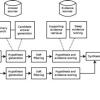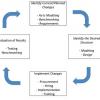Business Transformation Requires Transformational Leaders
Leadership and teaming skills are front and center in times of rapid change. Meet today’s constant disruption head on with expert guidance in leadership, business strategy, transformation, and innovation. Whether the disruption du jour is a digitally-driven upending of traditional business models, the pandemic-driven end to business as usual, or the change-driven challenge of staffing that meets your transformation plans—you’ll be prepared with cutting edge techniques and expert knowledge that enable strategic leadership.
Recently Published
For innovation to be valuable to an enterprise, it must have real tangible business impacts and be well positioned within the organization. Linking it to the underlying enterprise architecture (EA) demonstrates how ideas have evolved. Enterprise architecture needs to be able to address real innovation. If the architecture changes, what effect does this have on innovation and its related strategies? Innovation management and enterprise architecture go hand in hand. Although each can be successful in their own right, it’s when they are used in conjunction with each other that the full benefits are realized.
This edition of Cutter IT Journal features five articles that discuss existing and future (but not at all fictional) risks in what we currently call the Internet of Things and that in the very near future will evolve into the Internet of Everything (IoE). It presents examples of risks and attacks in the different domains of our personal life, commercial world, and industry in which IoT devices are used, and highlights the corresponding technological and managerial challenges for confronting — even anticipating and warding against — security attacks.
Digital transformation occurs in economies, sectors, and industries. Businesses can choose to embark on a journey that makes them more than just mere observers of the transformative changes. So what happens on this journey? And how can the businesses transform?
Agile isn’t going to help if we continue applying outdated change models to how we transform; that is, a bunch of change people — either Agile coaches, change management folks, or the vendor — gather in a room and create the plan.
IBM's Watson Plays Jeopardy!
In essence, a Jeopardy!-playing application posed two different problems: understanding natural language (NL) so as to be able to identify the right question and then searching a huge database of general information for an answer that fit the question. Searching a huge database quickly was a more-or-less physical problem, but parsing general questions in English and then determining which of several possible answers was the right match for the question being asked were serious cognitive problems.
Enterprise architecture plays a growing role in strategic discussions and decision-making, and many EA components are no longer contained within a single enterprise because they form part of a much wider environmental, social, or human ecology. In other words, we are at a crucial tipping point for EA, where the decisions that enterprise architects make play a vital role in our collective destinies and futures.
Organizations seeking to incorporate effective analytics programs will likely encounter several challenges along the way. Whereas many of these can be dealt with in the short term, others will require solutions that we do not know to exist at the present time. In the balance of this article, we discuss several of the challenges and possible solutions, while addressing the components involved in any BDA plan.
This article explores a single concern: describing the system-level capabilities required to derive maximum analytic value from a generalized model of NoSQL data. A generalized model is a model that works across all data sources no matter what type of data is present. Generalized analytics can answer all questions, from simple to complex, across all data types. This approach leads to eight well-defined, objective attributes, which collectively form a precise capabilities-based definition of a NoSQL analytics system.

















